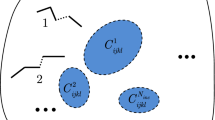Abstract
Crack growth in particle reinforced composites is significantly influenced by the character of the reinforcement particles. To accurately deal with such problems, the extended finite element method (XFEM) was employed and improved. The simulations are accomplished by using a new domain expression of an interaction integral for evaluating stress intensity factors (SIFs), and by adopting the maximum hoop stress criterion for crack-growth direction prediction. Crack deflection/attraction mechanisms and their associated energy release rate variations are investigated. It is shown that the applied numerical method allows a considerable flexibility and can be used in more general situations. The crack-tip shielding and amplifying behaviors are clearly observed.
Similar content being viewed by others
References
Tamate, O., The effect of a circular inclusion on the stresses around a line crack in a sheet under tension. International Journal of Fracture, 1968, 4(3): 257–65.
Sendechyj, G.P., Interaction of cracks with rigid inclusions in longitudinal shear deformation. International Journal of Fracture, 1974, 10(1): 45–52.
Hwu, C., Liang, Y.K. and Yen, W.J., Interactions between inclusions and various types of cracks. International Journal of Fracture, 1995, 73(4): 301–23.
Kassam, Z.H.A., Zhang, R.J. and Wang, Z.R., Finite element simulation to investigate interaction between crack and particulate reinforcements in metal matrix composites. Materials Science and Engineering, 1995, A203(1–2): 286–299.
Ayyar, A. and Chawla, N., Microstructure-based modeling of crack growth in particle reinforced composites. Composites Science and Technology, 2006, 66(13): 1980–1994.
Bush, M.B., The interaction between a crack and a particle cluster. International Journal of Fracture, 1997, 88(3): 215–232.
Knight, M.G., Wrobel, L.C. and Henshall, J.L., A study of the interaction between a propagating crack and an uncoated/coated elastic inclusion using the BE technique. International Journal of Fracture, 2002, 114(1): 47–61.
Kitey, R., Phan, A.V., Tippur, H.V. and Kaplan, T., Modeling of crack growth through particulate clusters in brittle matrix by symmetric-Galerkin boundary element method. International Journal of Fracture, 2006, 141(1–2): 11–25.
Williams, R.C., Phan, A.V., Tippur, H.V., Kaplan, T. and Gray, L.J., SGBEM analysis of crack-particle(s) interactions due to elastic constants mismatch. Engineering Fracture Mechanics, 2007, 74(3): 314–331.
Lei, J., Yang, Q.S., Wang, Y.S. and Zhang, C.Z., An investigation of dynamic interaction between multiple cracks and inclusions by TDBEM. Composites Science and Technology, 2009, 69(7–8): 1279–1285.
Kurumatani, M. and Terada, K., Finite cover method with multi-cover layers for the analysis of evolving discontinuities in heterogeneous media. International Journal for Numerical Methods in Engineering, 2009, 79(1): 1–24.
Chen, C.Q., Cui, J.Z., Duan, H.L., Feng, X.Q., He, L.H., Hu, G.K., Huang, M.J., Huo, Y.Z., Ji, B.H., Liu, B., Peng, X.H., Shi, H.J., Sun, Q.P., Wang, J.X., Wang, Y.S., Zhao, H.P., Zhao, Y.P., Zheng, Q.S. and Zou, W.N., Perspectives in mechanics of heterogeneous solids. Acta Mechanica Solida Sinica, 2011, 24(1): 1–26.
Jing, L., A review of techniques, advances and outstanding issues in numerical modeling for rock mechanics and rock engineering. International Journal of Rock Mechanics & Mining Sciences, 2003, 40(3): 283–353.
Belytschko, T., Moës, N., Usui, S. and Parimi, C., Arbitrary discontinuities in finite elements. International Journal for Numerical Methods in Engineering, 2001, 50(4): 993–1013.
Daux, C., Moës, N., Dolbow, J., Sukumar, N. and Belyschko, T., Arbitrary branched and intersecting cracks with the extended finite element method. International Journal for Numerical Methods in Engineering, 2000, 48(12): 1741–1760.
Huynh, D.B.P. and Belytschko, T., The extended finite element method for fracture in composite materials. International Journal for Numerical Methods in Engineering, 2009, 77(2): 214–239.
Sukumar, N. and Prévost, J.H., Modeling quasi-static crack growth with the extended finite element method Part I: Computer implementation. International Journal of Solids and Structures, 2003, 40(26): 7513–7537.
Huang, R., Sukumar, N. and Prévost, J.H., Modeling quasi-static crack growth with the extended finite element method Part II: Numerical applications. International Journal of Solids and Structures, 2003, 40(26): 7539–7552.
Belytschko, T. and Black, T., Elastic crack growth in finite elements with minimal re-meshing. International Journal for Numerical Methods in Engineering, 1999, 45(5): 601–620.
Moës, N., Dolbow, J. and Belytschko, T., A finite element method for crack growth with out re-meshing. International Journal for Numerical Methods in Engineering, 1999, 46(1): 131–150.
Babuška, I. and Melenk, J.M., The partition of unity method. International Journal for Numerical Methods in Engineering, 1997, 40: 727–758.
Moës, N., Cloirec, M., Cartraud, P. and Remacle, J.F., A computational approach to handle complex microstruture geometries. Computer Methods in Applied Mechani- cs and Engineering, 2003, 192(28–30): 3163–3177.
Dréau, K., Chevaugeon, N. and Moës, N., Studied X-FEM enrichment to handle material interfaces with higher order finite element. Computer Methods in Applied Mechanics and Engineering, 2010, 199(29–32): 1922–1936.
Yu, H.J., Wu, L.Z., Guo, L.C., Du, S.Y. and He, Q.L., Investigation of mixed-mode stress intensity factors for non-homogeneous materials using an interaction integral method. International Journal of Solids and Structures, 2009, 46(20): 3710–3724.
Yu, H.J., Wu, L.Z., Guo, L.C., He, Q.L. and Du, S.Y., Interaction integral method for the interfacial fracture problems of two non-homogeneous materials. Mechanics of Materials, 2010, 42(4): 435–450.
Rice, J.R., A path independent integral and the approximate analysis of strain concentration by notches and cracks. Journal of Applied Mechanics, 1968, 35: 379–386.
Dolbow, J., Moës, N. and Belytschko, T., Discontinuous enrichment in finite element with a partition of unity method. Finite Elements in Analysis and Design, 2000, 36(3–4): 235–260.
Dolbow, J. and Gosz, M., On the computation of mixed-mode stress intensity factors in functionally graded materials. International Journal of Solids and Structures, 2002, 39(9): 2557–2574.
Kim, J.H. and Paulino, G.H., An accurate scheme for mixed-mode fracture analysis of functionally graded materials using the interaction integral and micromechanics models. International Journal for Numerical Methods in Engineering, 2003, 58(10): 1457–1497.
Kim, J.H. and Paulino, G.H., Consistent formulations of the interaction integral method for fracture of functionally graded materials. Journal of Applied Mechanics, 2005, 72(3): 351–364.
Hutchinson, J.W. and Suo, Z., Mixed mode cracking in layered materials. Advances in Applied Mechanics, 1992, 29: 63–191.
Elguedj, T., Gravouil, A. and Combescure, A., Appropriate extended functions for X-FEM simulations of plastic fracture mechanics. Computer Methods in Applied Mechanics and Engineering, 2006, 195(7–8): 501–515.
Kim, J.H. and Paulino, G.H., On fracture criteria for mix-mode crack propagation in functionally graded materials. Mechanics of Advanced Materials and Structures, 2007, 14: 227–244.
Erdogan, F. and Sih, G.C., On the crack extension in plates under plane loading and transverse shear. ASME Journal of Basic Engineering, 1963, 85(4): 519–527.
Civelek, M.B and Erdogan, F., Crack problems for a rectangular plate and an infinite strip. International Journal of Fracture, 1982, 19(2): 139–159.
Author information
Authors and Affiliations
Corresponding author
Additional information
Project supported by the Program for New Century Excellent Talents in University (No. NCET-08-0152) and the Program of Excellent Team in Harbin Institute of Technology.
Rights and permissions
About this article
Cite this article
Wang, Z., Ma, L., Wu, L. et al. Numerical Simulation of Crack Growth in Brittle Matrix of Particle Reinforced Composites Using the XFEM Technique. Acta Mech. Solida Sin. 25, 9–21 (2012). https://doi.org/10.1016/S0894-9166(12)60002-0
Received:
Revised:
Published:
Issue Date:
DOI: https://doi.org/10.1016/S0894-9166(12)60002-0




